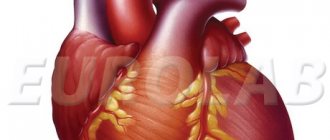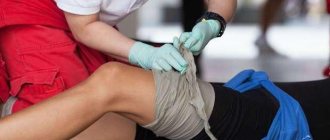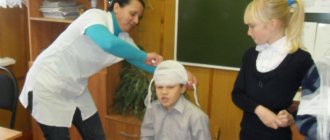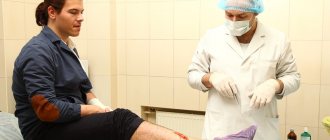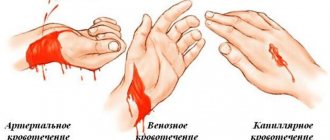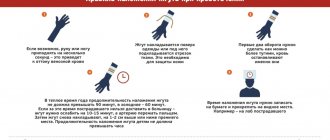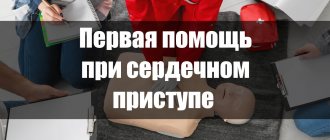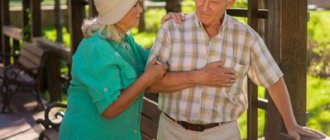Causes of fainting
- Fright, unexpected severe sharp pain, nervous shock. Because of them, a sharp decrease in blood pressure can occur, resulting in a decrease in blood flow, a disruption in the blood supply to the brain, which leads to fainting.
- Weakness of the body, especially if it is accompanied by nervous exhaustion. General weakness of the body, which can occur due to hunger, poor nutrition or constant anxiety, can cause low blood pressure and fainting.
- Staying in a room with a small amount of oxygen. A lack of oxygen can occur due to poor ventilation if the room is very smoky or there are a lot of people in it. In such a situation, the brain does not receive the required amount of oxygen, as a result of which fainting occurs.
- If you stand for a long time without moving. Lack of movement leads to stagnation of blood in the legs and reduces its flow to the brain. The result is fainting.
How does anaphylaxis occur?
When an allergen enters the body, the immune system begins to produce immunoglobulins. The body increases sensitivity to the effects of foreign substances and allergens, which manifests itself in the form of swelling, itching, and low blood pressure.
When the human body encounters an allergen for the second time, anaphylactic shock may occur. Immunoglobulins recognize a foreign substance (allergen), and mediators are released by immune cells in large quantities, which causes an allergic manifestation that is already tangible to a person.
In the absence of qualified medical care, death can occur.
Symptoms and signs of fainting
- The reaction is a short-term loss of consciousness, the victim falls. Lying in a horizontal position, the victim's blood supply to the brain improves, and after some time he comes to his senses.
- The airways are clear in most cases.
- The victim breathes rarely and shallowly.
- There is a rare and weak pulse.
- Dizziness, nausea, tinnitus, weakness, blurred vision, cold sweat, and numbness of the extremities also occur.
What causes anaphylactic shock?
Any substance can become an allergen. Allergic reactions accumulate in the body and the range of active camponetes expands. If there have already been manifestations of allergies, then an allergist and immunologist is needed to prevent unexpected and sad consequences in the near future.
The following may cause a reaction:
Medicines
For example:
- Medicines for the treatment of bacterial infections;
- Medicines that reduce skeletal muscle tone;
- Anesthetics;
- Vaccines.
Meat products may contain muscle relaxants and cause a reaction.
Insect bites . If a person is bitten by insects such as wasps or bees, anaphylactic shock may occur.
Food. The most allergenic include citrus fruits, milk, seafood, nuts, and various food additives.
Pollen. Flower or grass pollen can cause anaphylaxis.
Helminths. Parasitic diseases often cause an allergic reaction caused by waste products of helminths.
Too intense muscle work. Strenuous athletic training can cause anaphylaxis. Especially in combination with the use of various types of medications.
Providing first aid for fainting
- If the victim’s breathing is fine (the airways are clear, the pulse is palpable), you need to put him in a stable lateral position with his legs raised and his head bowed;
- When providing first aid, unfasten the victim’s constricting parts of clothing, such as a collar or belt, to provide access to fresh air;
- Splash your face with cold water. This will narrow the blood vessels and improve blood supply to the brain;
- Pat your cheeks, rub your chest and stomach;
- If the victim does not regain consciousness within a few minutes, most likely it is not fainting, and he needs medical help;
- Allow to inhale vapors of ammonia to stimulate the respiratory center;
- Monitor pulse, breathing, pupil size;
- If possible, give the victim who has regained consciousness some hot tea. After this, help him get up and sit down. There is no need to rush and immediately get him to his feet. If the person who wakes up after fainting experiences a faint state, lay him down again with his legs elevated.
- Do not forget that fainting can be a sign of a serious illness, and the victim needs a qualified medical examination.
– acute vascular insufficiency, in which the mass of blood circulating in the body decreases significantly and the overall vascular tone decreases.
Cardiac collapse can often lead to death, which is why it is so important to provide first aid during its attacks. Such dire consequences are due to the fact that the brain ceases to receive sufficient amounts of oxygen, which are delivered to it through the blood circulation.
First aid for emergency conditions of the cardiovascular system
Friday, May 17, 2019
Fainting is a brief loss of consciousness. When wondering how to provide first aid for fainting, you need to understand that such a problem is not independent, but only represents one of the signs of various disorders or malfunctions in the body. In the event that fainting occurs once, it can be attributed to excessive emotional stress or nervous shock. However, if a person loses consciousness quite often, there are definitely reasons for this, among which are the following:
- A decrease in blood pressure, provoked by both external factors and a variety of ailments.
- Violation of the full regulation of the cardiovascular system, accompanied by the outflow of blood from the brain. This manifestation is often associated with too much physical exertion or occurs due to a sudden change in body position.
- As a result of prolonged exposure to the rays of the scorching sun, heat stroke can occur, which can lead to fainting.
- Severe food and alcohol intoxication or pharmaceutical poisoning.
Just before losing consciousness, most people notice previous symptoms. Therefore, if the following phenomena occur, you should immediately help the person take a horizontal position.
· feeling of numbness in the upper and lower extremities;
· pallor of the skin;
· the appearance of ripples or “flies” before the eyes;
· cold sweat accompanied by icy feet and palms;
· nausea, vomiting;
Ringing, noise or feeling of stuffiness in the ears;
· severe weakness, in which the legs may give way.
A distinctive feature of fainting is a rapid heartbeat, accompanied by perspiration and redness of the skin.
Providing first aid for fainting and the above-described signs of an impending fainting condition requires not only a clear algorithm of actions, but also a number of certain things that are strongly not recommended to be done.
In particular, a person who is losing consciousness should not be sharply braked or shaken, which is often attempted by incompetent assistants. It is also prohibited to move the patient and force him into a sitting or upright position.
First aid
- The person needs to be helped to take a lying position and free him from compressive elements (loosen the belt, tie, unfasten the collar).
- If you have ammonia on hand (10% aqueous solution of ammonia), moisten a cotton swab with it and bring it to the victim’s nose, but not closer than 4-5 cm (ammonia vapor has a powerful stimulating effect on the breathing center
- The head moves slightly to the side so that the unconscious person does not choke on vomit.
- You need to open the windows to provide oxygen. If collapse occurs due to overheating in the sun, the patient must be immediately moved to the shade.
- The patient's lower limbs should be kept in an elevated position, which will provide additional oxygen flow to the brain.
Angina pectoris is a clinical syndrome characterized by a sensation or feeling of discomfort behind the sternum, occurs with coronary heart disease as a result of coronary insufficiency due to a decrease in the lumen of the cardiac artery.
During an attack of angina, there is a feeling of tightness or heaviness in the chest, pain radiates to the left side of the arm, shoulder or jaw. The person sweats a lot and has a feeling of fear.
Attacks of angina pectoris occur against the background of physical activity or strong emotional experience, which is relieved at rest. This is where exertional angina occurs. An attack can also occur at rest, that is, after sleep in the morning or at night. This is angina at rest.
First aid for angina pectoris.
- First of all, ease your breathing by unbuttoning the first buttons on your clothes, loosening the waistband of your trousers and skirts.
- If possible, place the patient in a semi-recumbent position. In this position, the heart's need for oxygen decreases and the attack quickly passes.
- Immediately place nitroglycerin under your tongue for immediate relief.
- If there are no medications, to relieve a painful attack, you can put mustard plasters on the area of the heart or chest (where the pain is felt).
- A hot mustard bath for your hands is also suitable. Take one tablespoon of dry mustard and dilute it in one liter of hot water. It will be enough to hold your hands in it for 5-7 minutes. Or immerse your hands in clean hot water for the same amount of time.
- Explain to the patient the correct breathing technique: it is better to breathe through the nose, slowly and deeply, holding at the height of inspiration and at the same time maximally protruding the upper abdomen. With this type of breathing, the air pressure in the chest decreases, which facilitates the flow of venous blood to the heart. Slow breathing allows the body to accumulate carbon dioxide, which leads to dilation of the blood vessels of the heart, which improves the supply of oxygen to the heart muscle.
Myocardial infarction is one of the clinical forms of coronary heart disease (CHD), which occurs with the development of ischemic necrosis (local tissue death) of a section of the myocardium (the muscular middle layer of the heart, constituting the bulk of its mass), due to the absolute or relative insufficiency of its blood supply.
Signs of myocardial infarction are:
- Very strong squeezing pain behind the sternum. It is not relieved by taking nitroglycerin. May radiate (give) to the left half of the chest, left arm or shoulder blade. Duration - from 20-30 minutes to several hours.
- Cold sweat.
- Dyspnea.
- Frequent and irregular pulse.
- The person suddenly turns pale and complains of fear of imminent death and lack of air.
- The patient is excited.
- Nausea, sometimes vomiting.
First aid:
- Provide the patient with complete rest and fresh air.
- Give nitroglycerin, warn that it must be completely absorbed. Give the next tablet after 5 minutes. Repeat no more than 3 times. If nitroglycerin is not available, give validol. It is necessary to measure blood pressure, because... it may drop sharply. If this happens, nitroglycerin and validol should not be given.
- Be sure to call an ambulance.
- To calm the patient, drop 30-40 drops of Valocordin or Corvalol onto a piece of sugar and let it dissolve.
- Give 1 tablet of aspirin (to reduce the process of thrombosis). The tablet must be chewed and washed down with water. You can give 2 tablets of analgin to reduce pain.
- Place mustard plasters on the calf muscles of the limbs as a distraction.
- If clinical death develops, begin chest compressions.
Causes of collapse
The causes of collapse can be very different - from past illnesses to age-related characteristics.
Causes of cardiovascular collapse:
- Large loss of blood, which may be the result of a rupture of an internal organ or serious external injuries to the body.
- Sudden change in body position while lying down
patient.
- Various past infections
diseases.
- Intoxication of the body (for example, an overdose of various drugs or food poisoning).
- Heart rhythm disturbances.
- Dehydration of the body.
- Severe electric shock.
- High ambient temperature.
- Strong doses of ionizing radiation.
| When providing medical care, it is necessary to correctly determine the cause that caused the collapse and direct all efforts to eliminate this factor. |
Drugs to relieve an attack
The main goal of emergency care for collapse is to increase blood volume. Saline solution does an excellent job of this.
However, it is contraindicated in cardiogenic shock due to the possible development of pulmonary edema. In this case, it would be appropriate to use norepinephrine, a pressor amine. Unlike sodium chloride solution, which is administered by stream, alpha-agonists are administered intravenously by drip.
Occasionally, dopamine is used instead of norepinephrine. It constricts the blood vessels of the muscles and skin well, but at the same time dilates the blood vessels of the internal organs.
All drugs are infused intravenously - administering the medicine intramuscularly or subcutaneously makes no sense due to collaptoid circulatory pathologies in the tissues.
Treatment
When you have urgently used the algorithm of actions and assistance, entrust the rest to the doctors. The ambulance team must restore normal activity of the circulatory system with the help of medications. Before using the drugs, measure blood pressure, look at the color of the skin, and count the number of heart beats per minute.
In some cases, hospitalization of the victim is necessary.
To stabilize the condition, sodium chloride solution is administered intravenously, glucocorticosteroids, anti-spasm agents, etc. are used. If hospitalization of the victim is necessary (it is impossible to find out the cause of the deterioration on the spot), an algorithm for providing assistance is determined in the conditions of a medical institution.
When bleeding occurs, it is stopped. If there are other reasons for the development of the condition, help consists in eliminating them and restoring all functions of the body.
Collapse requires a quick response from those who were near the person at the time the condition worsened. At home, help will consist of giving a comfortable position and bringing him to consciousness. You should not use medications if the exact cause of your deterioration is unknown. Only doctors can decide on the intravenous use of certain drugs. In some situations, hospitalization of the victim will be required.
Specifics of urgent actions
Before providing first aid for fainting and collapse, you must urgently call an ambulance, explaining in detail the condition of the victim.
Then pre-medical measures are carried out according to the following algorithm of actions:
- The patient is placed on a hard, flat surface on his back;
- You need to raise his legs by placing rolled-up clothes or a blanket under them;
- When bringing a person to consciousness, turn his head to the side;
- Provide the victim with the opportunity to breathe freely by unbuttoning or removing all oppressive clothing;
- If the attack occurred indoors, open all the windows so that there is free circulation of fresh air in the room;
- Place warm heating pads on the patient’s arms and legs;
- For head injuries or when a person is unconscious, bring a cotton swab soaked in ammonia to his nose;
- In the absence of medication, use the technique of rubbing the temples or earlobes.
If collapse is caused by injury and blood loss, emergency care begins with stopping the bleeding. After the victim has regained consciousness, and the doctors have not yet arrived, provide him with complete emotional and physical rest.
When first aid is provided for fainting and collapse, the following actions are prohibited:
- Offer the patient any medications;
- In an unconscious state, he is forbidden to pour water into his mouth;
- To bring a person to his senses by slapping his cheeks or shaking him.
Note!
Collapse caused by internal bleeding is stopped with tourniquets and twists! Simply apply an ice pack to the injured area.
Medical assistance
First aid is provided by ambulance doctors. Their task is to restore natural blood circulation in the body. For these purposes, perform the following actions:
- Administration of intravenous sodium chloride or Ringer's solution;
- Use of glucocorticoids and antispasmodics;
- Intravenous administration of vasopressors.
The dosage and selection of drugs is carried out taking into account the following indicators:
- Color of the skin;
- Arterial pressure;
- Number and frequency of heartbeat;
- Presence or absence of diuresis.
After hospitalization, complex therapy is carried out, which is designed to affect the body in 4 directions.
- Eliminate factors that threaten the life of the victim;
- Block the causes that caused the state of collapse;
- Restore lost body functions;
- Prevent possible respiratory failure with oxygen therapy.
Despite the wide variety of types of pathological conditions that cause collapse, they are all extremely dangerous to human life and require immediate medical attention.
Factors provoking a dangerous condition
What is collapse? This term literally translates as “fallen.” This name is associated with a sharp decrease in blood pressure to a critical level during an attack.
There are 2 reasons that cause a critical condition:
- Significant and rapid blood loss, due to which the total blood mass in the arteries and veins decreases;
- The destructive effects of toxic or poisonous substances, the impact of which reduces the elasticity of the vascular walls, reducing the overall tone of the circulatory system.
The pathological process progresses rapidly, due to the constantly increasing hypoxia of all systems and organs. The brain stops receiving oxygen, without which it cannot work, so the pressure in the arteries decreases even more, which poses a direct threat to the patient’s life.
Let us list the factors that provoke the development of collapse:
- Excessive internal or external bleeding;
- In case of poisoning with medications: neuroleptics, sympatholytics, adrenergic blockers;
- Toxic effects;
- Rapid change of body position for people who do not get out of bed due to illness;
- Low oxygen content in the room;
- Pancreatitis in acute course;
- Dehydration;
- Heatstroke;
- Electric shock;
- Previously acquired infectious diseases;
- Puberty (more often in girls);
- Pathological disorders of the myocardium, for example, with angina pectoris;
- Heart disease: heart attack, thromboembolism, hemopericarditis.
Note!
The occurrence of collapse is most often associated with complications of infectious diseases or severe pathological conditions.
At risk are patients who have suffered anaphylactic shock and patients with adrenal dysfunction.
The severity of the victim’s condition during the development of an attack depends on several factors:
- Age characteristics (in younger children and old age, the pathology is more severe);
- The degree of adaptation of the victim’s body to damage;
- Emotional and psychological characteristics of the patient.
In order for first-aid for a collapse to be provided correctly, it is necessary to find out the disease or factor that caused the attack, evaluate the symptoms, and check the basic reflexes. Only after these conditions are met do emergency care for collapse begin.
Classification and features of the course of an emergency condition
The manifestations of collapse are divided according to several criteria. Doctors most often use the classification of emergency conditions according to the etiological factor. Let us consider the types and features of manifestations of collapse according to this division.
- Infectious-toxic type. It is a consequence of infectious diseases caused by bacteria.
- Toxic look. The appearance of collapse is associated with the effects of toxic substances on the human body. Most often, such lesions occur in connection with the professional activities of the victim.
- Hypoxemic appearance. Meteorologically sensitive people are susceptible to such collapse during times of high atmospheric pressure or a small amount of oxygen in the air in the room.
- Pancreatic view. Occurs due to injury or pathological changes in the pancreas.
- Burn appearance. Caused by deep lesions of the skin as a result of thermal burns.
- Hyperthermic appearance. Triggered by sunstroke or prolonged exposure to high temperatures.
- Dehydration appearance. Caused by extreme dehydration of the body.
- Hemorrhagic collapse. Occurs against the background of massive internal or external bleeding.
- Cardiac (cardiogenic) collapse. A dangerous condition is provoked by cardiac pathologies.
- Orthostatic collapse. It occurs due to a sudden change in body position in bedridden patients. However, manifestations of pathology can also occur in healthy people, especially in adolescence and childhood.
- Plasmoragic type. The origin of the collapse is due to severe diarrhea.
A separate group includes the enterogenic type, or, as it is also called, fainting, which occurs in patients with gastrectomy after a heavy meal.
